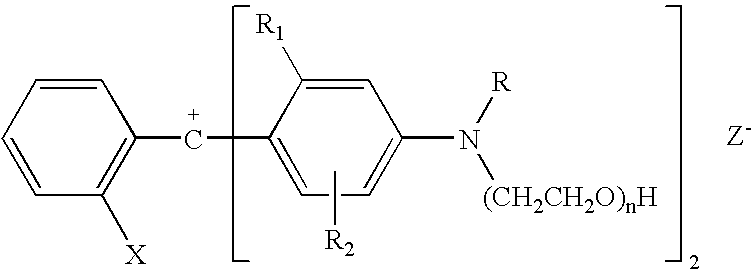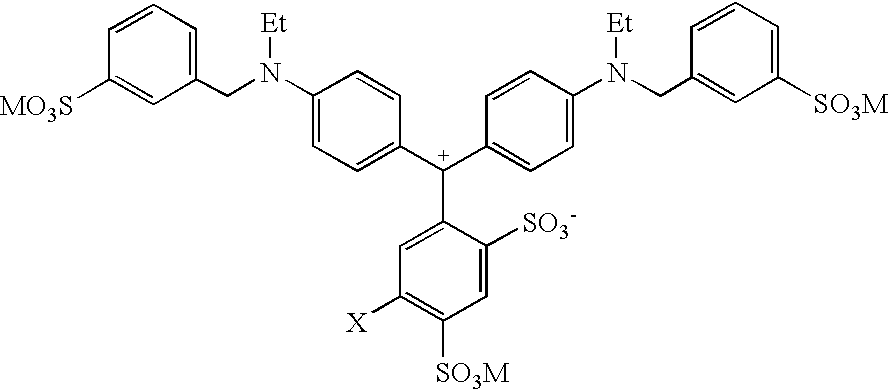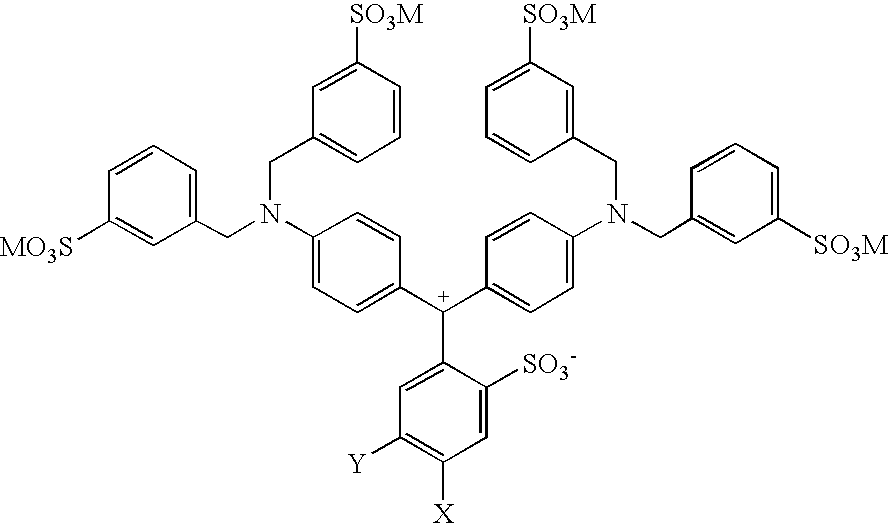Colorant compositions
a colorant composition and composition technology, applied in the field of surprising effectiveness, can solve the problems of large amount of effort to find the right molecular combination, inadvertent or undesirable discoloration, and high unpredictable substitution of groups in this manner
- Summary
- Abstract
- Description
- Claims
- Application Information
AI Technical Summary
Problems solved by technology
Method used
Image
Examples
example 1
[0043]
[0044] To a 500 mL 3-neck round bottom flask equipped with a condenser, thermometer and a N2 inlet was added 93% sulfuric acid (6.0 g), ortho-formylbenzene sulfonic acid sodium salt (11.5 g), urea (0.55 g), and tetrahydroquinoline 10EO (65.0 g). The ensuing reaction was stirred and heated to 85-95C for 3 hours under nitrogen. The reaction solution was then allowed to cool to 55-60 C and ammonium meta vanadate (0.44 g) was added. The ensuing reaction mixture was heated to 80-90C where a mixture of water (7.5 g) and 35% hydrogen peroxide (18.5 g) was slowly added. The mixture was then allowed to cool to ambient temperature where 200 g of additional water was added. The pH was adjusted to 5.5-6.5 with a 1:1 mixture of aqua ammonia and water to give an aqua green solution with a color value of 7.6 (measured with a Beckman DU 650 UV visible spectrophotometer; abs / g / L in Methanol) with a Max Abs of 645 nm.
example 2
[0045]
[0046] To a 3-neck 250 mL round bottom flask equipped with a condenser, thermometer and a N2 inlet was added water (5.0 g), muriatic acid (7.0 g), 1,3-benzene-disulfonic acid-4-formyl-disodium salt (11.9 g), urea (0.3 g), and tetrahydroquinoline 10 EO (43.8 g). The ensuing reaction was stirred and heated to 80C for 3 hours under nitrogen. The reaction solution was then allowed to cool to 50 C and ammonium meta vanadate (0.55 g) was added. The ensuing reaction mixture was heated to 75-90C where a mixture of water (5.5 g) and 35% hydrogen peroxide (13.0 g) was slowly added. After addition of the peroxide water solution, 140 g of additional water was added and the pH was adjusted to 5.5-6.5 with a 1:1 mixture of aqua ammonia and water to give an aqua green solution with a color value of 9.4 (measured with a Beckman DU 650 UV visible spectrophotometer; abs / g / L in Methanol) with a Max Abs of 647 nm.
[0047] Preparation of Aniline 2TBGE 10 EO (where TBGE is tert-butyl glycidyl ether...
example 3
[0052]
[0053] To a 3-neck 250 mL round bottom flask equipped with a condenser, thermometer and a N2 inlet was added muriatic acid (7.0 g), formylated aniline 2TBGE 10EO (32.0 g, 75% solids), urea 0.3 g), and tetrahydroquinoline 10EO (43.8 g). The ensuing mixture was stirred and heated to 80C for 3 hours under a N2 atmosphere. The reaction solution was then allowed to cool to 50 C and ammonium meta vanadate (0.55 g) was added. The ensuing reaction mixture was heated to 75-90C where a mixture of water (5.5 g) and 35% hydrogen peroxide (13.3 g) was slowly added. After addition of the peroxide water solution, 140 g of additional water was added and the mixture allowed to cool to 50C. The pH was adjusted to 5.5-6.5 with a 1:1 mixture of aqua ammonia and water to give a blue solution with a color value of 10.0 (measured with a Beckman DU 650 UV visible spectrophotometer; abs / g / L in Methanol) and a Max Abs of 611 nm.
[0054] mToluidine 2TBGE 10 EO was prepared in the following manner. To a ...
PUM
| Property | Measurement | Unit |
|---|---|---|
| Structure | aaaaa | aaaaa |
Abstract
Description
Claims
Application Information
 Login to View More
Login to View More - R&D
- Intellectual Property
- Life Sciences
- Materials
- Tech Scout
- Unparalleled Data Quality
- Higher Quality Content
- 60% Fewer Hallucinations
Browse by: Latest US Patents, China's latest patents, Technical Efficacy Thesaurus, Application Domain, Technology Topic, Popular Technical Reports.
© 2025 PatSnap. All rights reserved.Legal|Privacy policy|Modern Slavery Act Transparency Statement|Sitemap|About US| Contact US: help@patsnap.com



